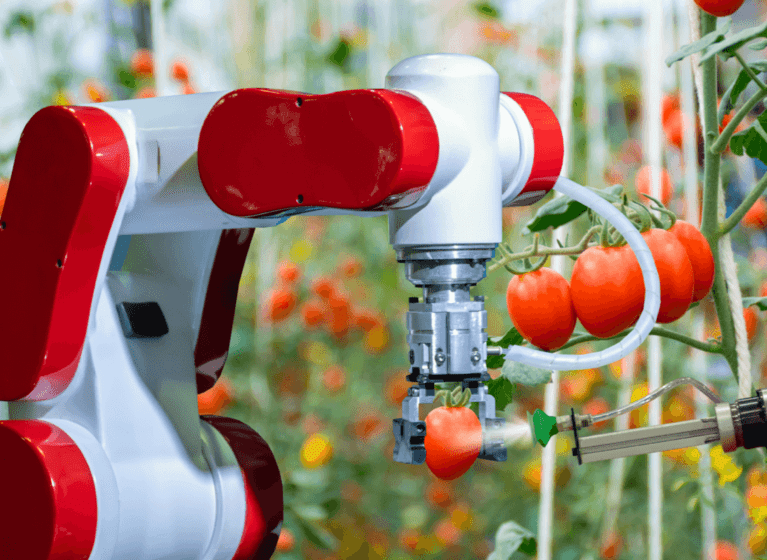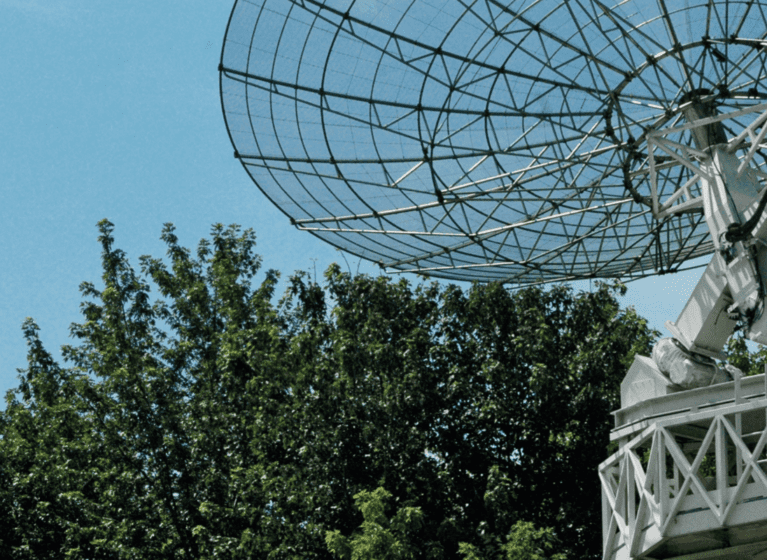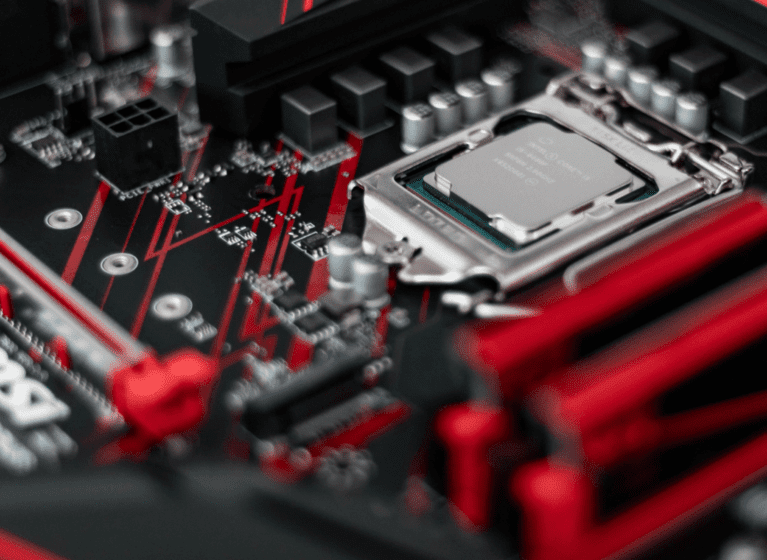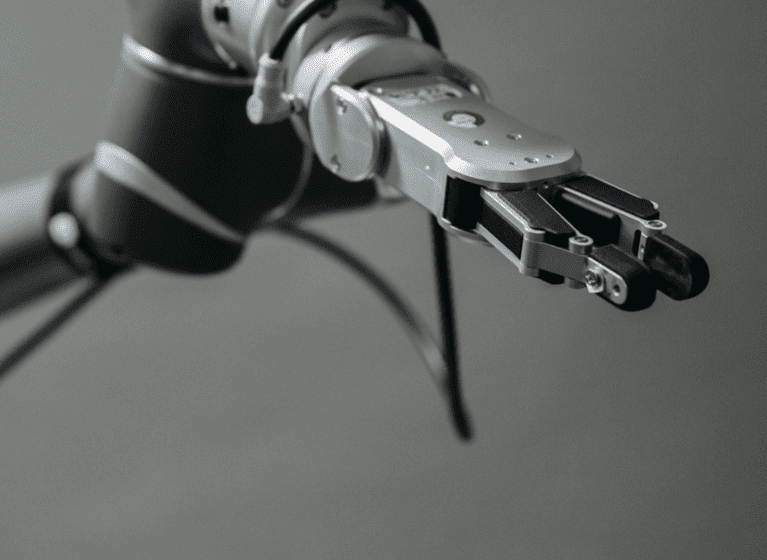What is essential for the continual feeding, clothing and survival of the world’s current and future population? Agriculture, one of the oldest fields of human innovation, and a field in which constant innovation and improvement is needed if we are to keep up with these demands.
‘AgTech’ is a term often used to refer to the application of advances in technology for agricultural processes – driving improvements in the efficiency, productivity and sustainability of agriculture amidst growing populations and changing social, economic and climate considerations. AgTech encompasses everything from seeds, soils and fertilisers engineered for higher yield and pest resistant crops through to automation, robotics, smart sensors and precision monitoring, and much more.
The human eye can tell us a lot about our environment – a perceptive gardener can tell when their plants have too much water or not enough sunlight based only on the colour of their leaves; a skilled eye can spot the ripest fruit on a branch; and an experienced farmer can gauge the outlook of their crops or flocks, at a glance. But what if we could see even more? Advanced image processing techniques have the potential to support improved and sustainable agriculture on a global industrial scale.
In this article we take a look at the application of image processing technologies to the field of agriculture, including techniques applied to remote sensing data. In particular, with innovations in this fast-growing area being increasingly protected by patent rights, we analyse these developments through the lens of patent data.
A growing area of technology
Significant innovative developments in the separate worlds of agriculture and image processing have been prevalent for some time, with the pace of such technical progress continuing to increase. See our recent article on innovation and patents in the world of AgTech. Patent analytics reveal that the intersection between these technologies has recently seen disproportionate expansion, indicating a niche but emerging area of technology.
Looking at the publication of patents and patent applications over the last decade, based on International Patent Classification (IPC) codes, inventions relating to image processing in agriculture is an area of recent and increasing growth, as can be seen in the graph below. Advancements in computing power, satellite imagery, IOT devices and artificial intelligence, alongside agriculture’s growing demand for richer and more sophisticated data, are likely fuelling this growth.
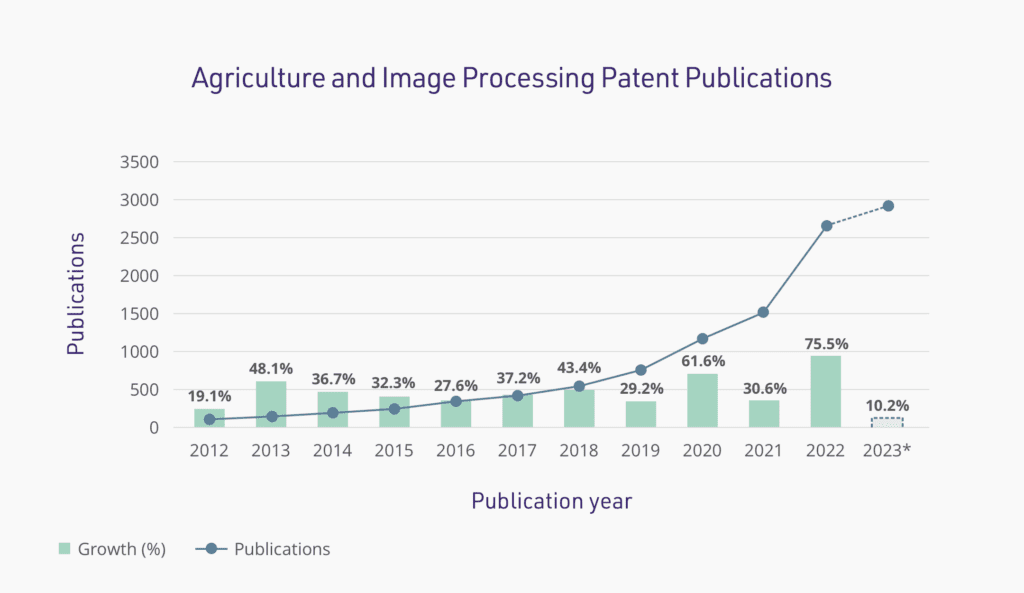
The above numbers are based on patent publications, in the Derwent World Patents Index, classified as related to: agriculture; forestry; animal husbandry; hunting; trapping; fishing (IPC:A01); and image data processing (IPC:G06V), or image or video recognition or understanding (IPC:G06T) as of December 2023. *Because patents are generally not published until 18 months after their original filing date, the data for 2023 is incomplete.
As a general point of comparison, the World Intellectual Property Organisation’s (WIPO’s) report on ‘World Intellectual Property Indicators 2022’1 indicated that global patent filings, for all technologies, grew by 3.6% in 2021, and from 2007 to 2020 grew by an average of approximately 5.3% year on year.
Relatively speaking, patents relating to image processing in agriculture appear to be growing even faster than those in the general fields of either agriculture or image processing. Whilst this is not necessarily an ‘apples-to-apples’ comparison, it does indicate an exciting trend of the application of what was once a relatively niche field of endeavour to the area of agriculture. This aligns with the general pattern we have seen in so many other fields of human invention: as foundational technologies mature, they disseminate into ever more specialised applications.
Organisations active in patenting in this area include companies already active in other agro-industry sectors, as well as tech giants venturing into the field. In addition to the larger organisations operating at tree top level, there are many seedlings and saplings innovating in this general field, including home grown start-ups and specialist SMEs. Across all types and sizes of such organisations, patents continue to play an essential part in fostering and rewarding innovation.
From established industry leaders to the latest start-ups, the cross-pollination of image processing and agriculture has already made great advances in boosting efficiency and sustainability. Looking to the future, if recent growth is any indicator, this blossoming activity promises to contribute solutions to some of the ‘big picture’ issues facing our world, including climate change, food scarcity and population growth.
Zooming in on image processing in AgTech
Image processing, and its applications in AgTech, encompasses a broad range of technologies, from the intercontinental macroscopic to the sub-cellular microscopic.
Examples of these technologies include:
- Satellite imagery for large-scale monitoring: Satellite-based remote sensing provides a macro view of agricultural regions, with image processing enabling the assessment at wide scale of factors such as weather patterns, crop and soil health and land use, as well as monitoring of livestock and other assets.
- Precision farm mapping: Image processing is a key component of precision agriculture, where image data from various sources is used to create detailed maps of fields and identify particular characteristics and trends in areas over time.
- Macro-crop health monitoring: Drones or ground-based cameras capture images of fields, these images are then processed to assess the health of crops, detecting signs of diseases, nutrient deficiencies, or stress.
- Crop counting and yield estimation: Using image analysis, it is possible to quantify the crops in a field and estimate yield. Such techniques are applicable on the scale of a single plant to multiple crops across vast areas.
- Livestock monitoring: Image processing can be applied to livestock management by tracking animal health and behaviour, from single animals to large herds.
- Robotics and automation: Image processing techniques are crucial for robotic and automated technologies in the recognition of plants, animals and other farm assets, from navigating between rows of crops to automated grooming of animals. Before robots can effectively participate in agricultural techniques they must be able to understand and localise within the local environment.
- Produce grading and sorting: High-resolution cameras can be used to inspect and grade fruits and vegetables based on size, shape, colour and other characteristics, and so facilitate automated sorting and packaging.
- Weed and pest detection and management: Image processing technology can identify and classify weeds in fields and/or identify and track the movement of pests such as insects or rodents. This information is used to create precise weed and pest control strategies, including for example via targeted spray application and drone technologies.
- Microscopy imaging and processing: Collected plant tissue or seed samples may be evaluated via imaging techniques using high-resolution microscope cameras at various magnifications, with the images processed to determine factors such as cell count or morphology to classify plant cells and to provide insights into plant health and growth patterns.
Regardless of the scale, the insights gained in such image processing techniques may be fed back into systems and platforms to allow farmers to make more informed decisions about their crops, their animals and their future planning.
Patenting AgTech image processing inventions
The latest image processing applications in the world of agriculture, as discussed above, include a broad range of patentable inventions. In order for an invention to be considered patentable, the principal requirements for patenting are that the invention is:
- novel – new and different compared to the relevant existing “prior art” (publicly available information including published patents, academic articles, online announcements etc.);
- non-obvious (i.e. involve an inventive step) – the differences of the invention over the prior art must not be trivial or routine (in the eyes of someone skilled in the relevant field of technology; and
- patentable-type subject matter – legally eligible for patent rights, i.e. sufficiently technical and concrete in nature.
In general, for an invention to be patentable it must be more than a mere discovery, abstract idea or scheme, it must have a technical character with practical application and utility in a field of economic endeavour.
Even where a known image processing technique is applied to a known agricultural process, this may still give rise to potentially patentable rights if that application is new and non-obvious. Positive indicators of patentability for such applications include the need to make technical adaptation, the solving of technical problems, or the overcoming of obstacles in order to arrive at the new concept.
In establishing an invention as patentable, it can also be helpful to show how the invention is more than the sum of its parts, how it contributes to the state of the art, how it provides advantages above and beyond existing technologies, and/or how it provides surprising or unexpected results.
Conclusion
The intersection of image processing and agriculture highlights how emerging technologies can bring new solutions to and invigorate established systems, building on the essential agricultural products and services on which we all rely.
While agriculture has ancient roots, the burgeoning integration of advanced image processing techniques in AgTech clearly demonstrates the continuing importance of innovation to farming practices and related research work, from satellite imagery through farm management down to the microscopic scale.
Given the growth of patenting for these technologies, the fruits of such innovations will no doubt continue ripening in the seasons ahead.
Here at FPA Patent Attorneys, we have deep knowledge and experience in these technologies. If you are interested in protecting your innovations in this space, please get in touch with our Agribusiness team.


